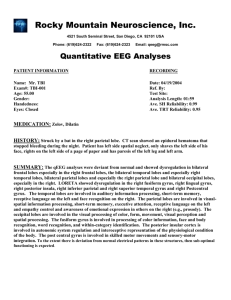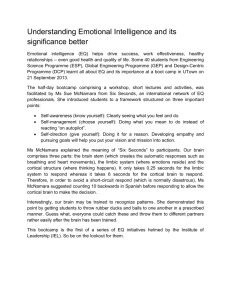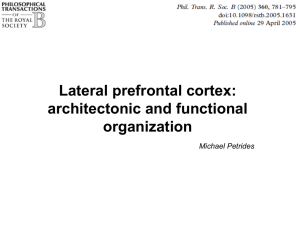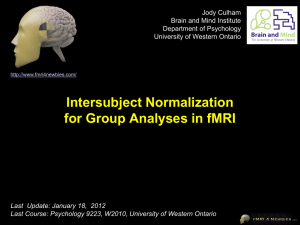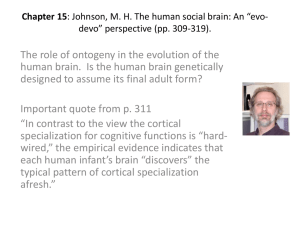Author Guidelines for 8 - Shattuck Research Group
advertisement
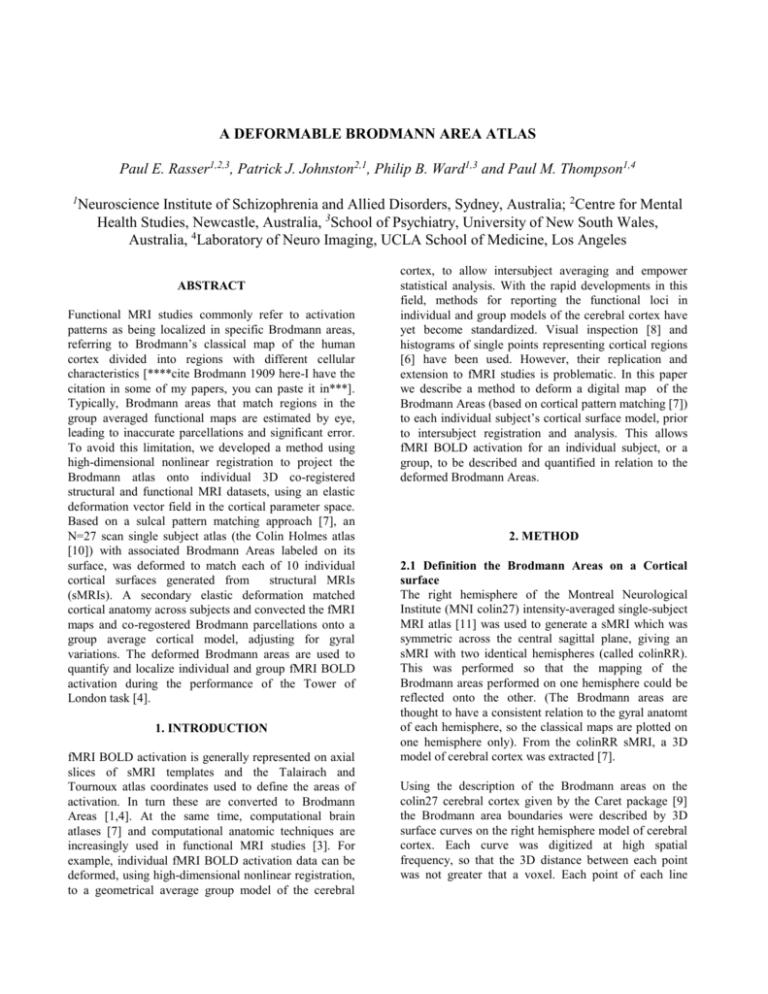
A DEFORMABLE BRODMANN AREA ATLAS
Paul E. Rasser1,2,3, Patrick J. Johnston2,1, Philip B. Ward1,3 and Paul M. Thompson1,4
1
Neuroscience Institute of Schizophrenia and Allied Disorders, Sydney, Australia; 2Centre for Mental
Health Studies, Newcastle, Australia, 3School of Psychiatry, University of New South Wales,
Australia, 4Laboratory of Neuro Imaging, UCLA School of Medicine, Los Angeles
ABSTRACT
Functional MRI studies commonly refer to activation
patterns as being localized in specific Brodmann areas,
referring to Brodmann’s classical map of the human
cortex divided into regions with different cellular
characteristics [****cite Brodmann 1909 here-I have the
citation in some of my papers, you can paste it in***].
Typically, Brodmann areas that match regions in the
group averaged functional maps are estimated by eye,
leading to inaccurate parcellations and significant error.
To avoid this limitation, we developed a method using
high-dimensional nonlinear registration to project the
Brodmann atlas onto individual 3D co-registered
structural and functional MRI datasets, using an elastic
deformation vector field in the cortical parameter space.
Based on a sulcal pattern matching approach [7], an
N=27 scan single subject atlas (the Colin Holmes atlas
[10]) with associated Brodmann Areas labeled on its
surface, was deformed to match each of 10 individual
cortical surfaces generated from
structural MRIs
(sMRIs). A secondary elastic deformation matched
cortical anatomy across subjects and convected the fMRI
maps and co-regostered Brodmann parcellations onto a
group average cortical model, adjusting for gyral
variations. The deformed Brodmann areas are used to
quantify and localize individual and group fMRI BOLD
activation during the performance of the Tower of
London task [4].
1. INTRODUCTION
fMRI BOLD activation is generally represented on axial
slices of sMRI templates and the Talairach and
Tournoux atlas coordinates used to define the areas of
activation. In turn these are converted to Brodmann
Areas [1,4]. At the same time, computational brain
atlases [7] and computational anatomic techniques are
increasingly used in functional MRI studies [3]. For
example, individual fMRI BOLD activation data can be
deformed, using high-dimensional nonlinear registration,
to a geometrical average group model of the cerebral
cortex, to allow intersubject averaging and empower
statistical analysis. With the rapid developments in this
field, methods for reporting the functional loci in
individual and group models of the cerebral cortex have
yet become standardized. Visual inspection [8] and
histograms of single points representing cortical regions
[6] have been used. However, their replication and
extension to fMRI studies is problematic. In this paper
we describe a method to deform a digital map of the
Brodmann Areas (based on cortical pattern matching [7])
to each individual subject’s cortical surface model, prior
to intersubject registration and analysis. This allows
fMRI BOLD activation for an individual subject, or a
group, to be described and quantified in relation to the
deformed Brodmann Areas.
2. METHOD
2.1 Definition the Brodmann Areas on a Cortical
surface
The right hemisphere of the Montreal Neurological
Institute (MNI colin27) intensity-averaged single-subject
MRI atlas [11] was used to generate a sMRI which was
symmetric across the central sagittal plane, giving an
sMRI with two identical hemispheres (called colinRR).
This was performed so that the mapping of the
Brodmann areas performed on one hemisphere could be
reflected onto the other. (The Brodmann areas are
thought to have a consistent relation to the gyral anatomt
of each hemisphere, so the classical maps are plotted on
one hemisphere only). From the colinRR sMRI, a 3D
model of cerebral cortex was extracted [7].
Using the description of the Brodmann areas on the
colin27 cerebral cortex given by the Caret package [9]
the Brodmann area boundaries were described by 3D
surface curves on the right hemisphere model of cerebral
cortex. Each curve was digitized at high spatial
frequency, so that the 3D distance between each point
was not greater that a voxel. Each point of each line
describing a Brodmann area border was then mapped to
the nearest point on the cortical surface.
The cortical surface model with the Brodmann area
boundaries was converted to a file format compatible
with the cortical pattern matching method [7] where each
hemisphere is represented by 256 x 256 vertices. Each
vertex was then labeled with a number defined by its
inclusion within a Brodmann Area (i.e. a vertex within
Brodmann area 22 was given the label 22). Because the
gyral patterning of the left and right hemispheres is
different, the resulting right hemisphere vertices with
Brodmann area labels were elastically transformed to
match the left hemisphere sulci to provide a parcellated
left hemisphere model. Figure 1 shows the lateral left
view of the colinRR cerebral cortex model with the
Brodmann areas and Brodmann area boundaries.
Figure 1 Brodmann Areas and Brodmann Area
boundaries displayed on the colinRR cerebral cortex 3D
surface model.
2.3 Acquisition of Individual Subjects’ sMRI and
fMRI data
To apply the deformable Brodmann area model to an
individual subject, the sMRI and fMRI BOLD activation
data were acquired using a Magnetom Vision 1.5 T MRI
scanner (John Hunter Hospital, {**right-justify text
here**}Newcastle).The sMRI of the subject was
collected with approximate dimensions of 164x 256x256
{***missing symbol ‘x’?**} with each voxel being
approximately 1.0 ×1.0 × 1.0 mm3. fMRI BOLD
activation volumes were collected with the echoplanar
imaging technique (EPI).T2-weighted sequences were
acquired using a 64 by 64 matrix and 16 axial slices (TR
= 2.7 s, 6.25x6.25x8 mm resolution {**missing ‘x’
symbol here?**}).
While lying in the MR scanner, the subject was
presented with 7 Tower of London tasks [4] of difficulty
varying from 0 (zero-move) to 7 (active). Briefly, this
task …. {**add one sentence telling people what the task
is supposed to activate**} During each task, 10 fMRI
volumes were acquired resulting in 70 volumes per run
(covering the total brain volume). This sequence was
repeated 3 times.
2.4 Preprocessing sMRI and fMRI. The fMRI BOLD
data were motion corrected across all three sequences
using SPM99 [**add ref?**Frackowiak et al., 2000 book
will do**]. A two-step intensity normalization procedure
was adopted. Within each sequence, images were
intensity normalized to give a mean volume intensity of
1000. A mean image for each sequence was generated,
and subtracted from every individual volume within its
associated acquisition sequence. This resulted in (for
each sequence) a mean baseline of zero at every voxel,
with individual volume acquisitions representing
variation around that mean. Volumes across all
sequences were then concatenated to produce a single
series. Data were subsequently co-registered to the sMRI
and spatially smoothed using a Gaussian filter with a full
width at half maximum(FWHM) of 15x15x9 mm3.
Student’s t-tests were performed at each voxel
comparing the zero-move versus active tasks, with the
results represented as maps of z-scores.
The subject’s sMRI was then aligned to an ICBM [2]
template followed by digital filtering to reduce intensity
inhomogeneity due to radio-frequency bias [5]. A 3D
parametric surface model of the cerebral cortex was then
extracted from the subject’s aligned sMRI [7]. The zscores were then mapped to the subject’s cortical surface
model and clustered based on positive z score >
3.88.(P<0.05 corrected for multiple comparisons) and z
< -3.88 (P<0.05 corrected for multiple comparisons) for
negative z scores.
2.5 Sulcal Tracing and Warping
For both the colinRR and the subject’s cerebral cortex
model, at least 15 sulci were identified on each
hemisphere and traced (depending on existence). Six
control lines mapping the midline hemisphere boundaries
at the interhemispheric margin were also identified and
traced onto the cortical surface models [10]. These
surface curves are used as landmarks in the geometric
averaging and warping of subjects to create an average
models of cerebral cortex [3,6].
Using the covariant version of the Navier Cauchy partial
differential equations [7], the colinRR model of cerebral
cortex was elastically deformed to the individual
subject’scortical surface model. This process sets up a
computed correspondence between the two surfaces by
projecting corresponding sulcal landmarks into the
cortical parameter space, and computing a flow field that
matches them exactly. .
The vertices of the deformed colinRR cortex were then
used to poll the undeformed colinRR cortex with
Brodmann area labeled vertices for the nearest
(Euclidean distance) vertex. The Brodmann area label
associated with this undeformed vertex location was then
allocated to the deformed vertex to form the deformed
and labeled colinRR cerebral cortex model. Finally, as
the individual subject’s cortical surface model and the
deformed and the labeled colinRR cerebral cortex model
are in the same space, the Brodmann area labels were
assigned to individual subject’s cortical surface, giving
the Brodmann areas and 3D curved Brodmann area
boundaries on the subject’s cerebral cortex model.
3. RESULTS
For the purposes of this paper just the left hemisphere
has been used for the analysis. Figure 2 shows the
deformed Brodmann area labels over the subject’s
cortical surface model. The color coding indicates the
Brodmann area. From Figure 2, the adaptation of the
Brodmann areas to the sulci, via the flow in the cortical
parameter space, can be seen. In particular, the
boundaries of Brodmann areas 20, 21 and 22 align
correctly with the inferior and superior temporal sulci.
Figure 2: Left lateral view of color-coded Deformed
Brodmann Areas elastically adapted to the individual
cortical surface.
Figure 3: Left lateral view of the deformed Brodmann
Area partition mapped onto an individual surface that is
also texture-mapped with the individual cortical surface
Z-scores (p<0. thresholded)
Using the functional information described in Section
2.4, Figure 3 shows the deformed Brodmann Area on the
individual cortical surface Z-scores (p<0.05 thresholded
for multiple comparisons).
Clusters of BOLD functional information were then
classified and quantified based on the percentage of the
cluster lying within a Brodmann area. Table 1 shows the
anatomical region, Brodmann area and percentage of the
cluster lying in the Brodmann area, with the number of
vertices consisting the cluster, as well as the maximum,
mean and average deviation {*do you mean standard
deviation here?*} of the Z score of the cluster.
Anatomical
Region
Brodmann Area [% of cluster]
2
9[16%],10[81%],46[3%]
3
6[100%]
4
1[10%],2[71%],40[19%]
5
7[100%]
8
10[9%],11[78%],NA[14%]
Unit count Zmax
of cluster of cluster
770
5.424
335
5.03
31
4.571
26
4.44
1414
-9.468
Mean Z
of cluster
4.511
4.224
4.194
4.107
-5.716
Average
deviation
Of cluster
0.168
0.047
0.032
0.021
2.42
9
19[32%],22[7%],37[29%],39[32%] 457
-6.778
-5.029
0.598
10
21[14%],38[86%]
49
-6.647
-4.909
0.533
11
20[93%],37[7%]
58
-6.385
-4.81
0.463
Table 1: .Cluster (N>20 units critically thresholded at P<0.05 and corrected for multiple comparisons. These clusters
describe regions with significant BOLD response (block design) when performing the Tower of London Task. (NA denotes
undefined Brodmann Area {**perhaps say why this is possible?**})
1.
CONCLUSIONS AND FUTURE WORK
We have described a deformable Brodmann Area atlas
method that allows for visual and tabular quantification
of individual and group structural and functional data.
The deformation was based on matching the sulcal
pattern of the subject with that of the labeled atlas. This
set of deformed Brodmann areas was applied to the
sMRI and fMRI BOLD activation of a subject while
performing the Tower of London Task, providing a
standardized measure of activation on the cortical
surface. While this description of the Brodmann areas
represents the most accurate available to the authors at
the time, it would be desirable to have detailed
Brodmann cytoarchitectonic areas obtained from postmortem brains, perhaps including probabilistic maps
{**cite Zilles or Amunts, who did a probabilistic BA for
SS I**}. With this, and application of the same methods
as described in this paper, investigations into the sulcal
and gyral features which best align the deformable
Brodmann areas to an individual and the relationship
between the Brodmann Areas and function could be
rigorously established.
5. ACKNOWLEDGMENTS
P.M. , Analysis of fMRI BOLD activation during the
Tower of London Task using Cortical Pattern Matching,
Schizophrenia Research, Vol 6, No 1, pp. 232, 2003.
[4] Schall, U., Johnston, P., Lagopoulos, J., Jüptner, M.,
Jentzen, W., Thienel, R., Dittmann-Balçar, A., Bender,
S., Ward, P.B., Functional brain maps of Tower of
London performance: A PET and fMRI study.
NeuroImage 2003, 20: 1154-1161, 2003.
[5] Sled JG, Zijdenbos AP, Evans AC, A non-parametric
method for automatic correction of intensity nonuniformity in MRI data. IEEE Trans Med Imaging
17:89-97, 1998.
[6] Sowell, E.R., Peterson, B.S., Thompson, P.M.,
Welcome, S.E., Henkenius, A.L., Toga, A.W., Mapping
cortical change across the human life span, Nature
Neuroscience, 2003. {**pages?**}
[7] Thompson, P.M., MacDonald, D., Mega, M.S.,
Holmes, C.J., Evans, A.C., Toga, A.W., Detection and
Mapping of Abnormal Brain Structure with a
Probabilistic Atlas of Cortical Surfaces, J. of Comput
Assist Tomogr ,21(4):567-581, 1997.
NISAD is supported by infrastructure funding from
NSW Health, http://www.nisad.org.au. Algorithms also
supported by NIH R21 grants NCRR RR19771 and
NIBIB EB01561 (to PT).
[8] Thompson. P.M., Mega, M.S., Vidal, C. Rapoport,
J.R., and Toga, A.W. Detecting Disease-Specific
Patterns of Brain Structure Using Cortical Pattern
Matching and a Population-Based Probabilistic Brain
Atlas, IPMI2001,pp.488-501, 2001
11. REFERENCES
[9] http://brainmap.wustl.edu/caret
[10]
http://www.loni.ucla.edu/NCRR/Protocols/SulcalAnatom
y.html
[1] Brett, M., Johnsrude, I.S. and Owen, A.M., The
problem of functional localization in the human brain,
Nature Reviews Neuroscience, Vol 3, pp 243-249,
March 2002.
[2] Collins DL, Neelin P, Peters TM, Evans AC,
Automatic 3D intersubject registration of MR volumetric
data in standardized Talairach space. J. Comput Assist
Tomogr ;18(2):192-205, 1994.
[3] Rasser, P.E., Johnston, P., Lagopoulos, J., Ward
P.B., Schall, U., Thienel, R., Bender, S., and Thompson,
[11] http://www.mrccbu.cam.ac.uk/Imaging/mnispace.html
